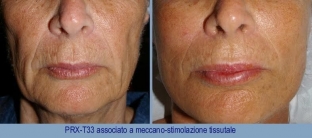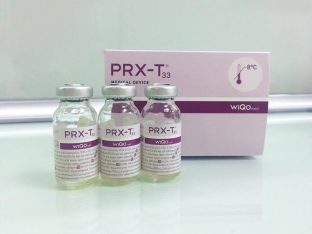Trichloroacetic acid (TCA - trichloracetic acid) is one of the most popular and widely used components of cosmetic skin cleansing procedures, since, depending on the concentration, it can be used for both superficial and medium peels, achieving excellent anti-aging results. The median TCA peeling gives a particularly impressive lifting effect, however, the skin after it takes time to rehabilitate. U-AESTHETICS provides a new perspective on the benefits of Trichloroacetic Acid, which, in PRX-T33 therapy, does not harm the skin. Due to what remoteness to achieve such an effect, considered estet-portal.com.
Trichloroacetic acid – a key factor in launching anti-aging processes in the skin
Acid peeling is a controlled chemical injury to the skin that stimulates the skin to exfoliate dead skin layers and renew skin cells. One of the most powerful dermal function stimulants used for controlled damage to the skin to stimulate skin regeneration – it is trichloroacetic acid (TCA). Let's take a closer look at how this stimulation occurs.
Age-related skin changes are caused by various processes – this is a decrease in the level of sex hormones, and the damaging effect of environmental factors. These processes trigger photo- and chronoaging in the skin. With chronoaging, the following changes in skin quality are observed:
- smoothes the dermo-epidermal junction;
- cells of the basal layer are deformed;
- the number of melanocytes and Langerhans cells decreases;
- the granular and spiny layers are thinning;
- the secretory functions of the glands in the dermis are deteriorating
- the level of glycosaminoglycans decreases;
- capillaries of dermal papillae atrophy;
- destruction of collagen and elastin fibers accelerates.
Aggressive UV rays add a damaging effect to the skin, provoking pigmentation disorders, the development of hyperkeratosis, and the appearance of telangiectasias.
In order to remodel the dermis and epidermis, it is important to achieve the production of one's own growth factors. This can be done by inducing a hormonal skin response to stress, and this response can be stimulated by trichloroacetic acid.
Applied to the skin, TCA provokes a hormonal response directly, regardless of the hypothalamic-pituitary axis. Controlled inflammation triggers the release of pro-inflammatory cytokines, due to which, in the course of a series of transformations, beta-endorphins, adrenocorticotropic and melanostimulating hormones are released. They contribute to the release of growth factors, enhance the proliferation of keratinocytes and fibroblasts, and increase the level of cell renewal.
The therapeutic effect of TCA is directly dependent on concentration: the dermal level of action is only achieved at a concentration of more than 30%. The effect on the papillary layer can be obtained at 30-35% concentration of TCA, intense stimulation of this layer in combination with the activation of fibroblasts helps to form a deposit of newly formed collagen, elastin and glycosaminoglycans.

Anti-Aging Trio: Trichloroacetic Acid and Other Ingredients PRX-T33
High concentration TCA peels are considered to be quite stressful for the skin due to the depth of exposure. Usually, the patient should be warned that the median TCA peel carries the risk of pigmentation disorders, causes severe edema and hyperemia, and therefore requires at least a week's rehabilitation period.
The PRX-T33 therapy, introduced to our market by U-AESTHETICS, non-invasively stimulates the dermis to remodel it. It is based on the use of highly concentrated trichloroacetic acid combined with hydrogen peroxide and kojic acid.
PRX-T33 is an innovative, patented formula containing 33% TCA, 5% kojic acid and low concentration hydrogen peroxide. The innovativeness of the composition is that to neutralize the aggressive action of TCA, not buffer additives were used, but its modulation with hydrogen peroxide.
The task of TCA is to activate growth factors by deep stimulation of the dermis, and peroxide prevents the caustic effect of acid, modulates tissue hydration, enhances the mechanisms of stimulation of dermal cells, preparing their receptors for the perception of growth factors. It is important to note that hydrogen peroxide in high concentration (from 1.5%) sharply slows down regeneration processes, and in low (1.3%) – on the contrary, it enhances An important role of kojic acid is to inhibit post-inflammatory pigmentation.
Thanks to the synergy of the three active ingredients in PRX-T33 therapy, it was possible to neutralize the damaging effect of acid peeling, while increasing the therapeutic effect and making it possible to carry out the procedure all year round.
PRX-T33 therapy does not cause a frost effect, passes without burning and pain, does not require a rehabilitation period. It can be recommended at any age if indicated and gives a good result in correcting the following aesthetic deficiencies:
- photo- and chronoaging;
- post-acne,
- atrophic scars;
- stretch marks;
- signs of pigmentation disorders;
- melasma, chloasma;
- hyperkeratosis of the skin of the face.
PRX-T33 can be used both as monotherapy and as an adjunct to facial contouring or facial oval correction with cosmetic threads, combined with laser and radiofrequency therapy, enhancing the results of other procedures. In combination with microneedling, PRX-T33 has the effect of a liquid laser, allowing you to correct atrophic skin changes and scars, carrying out intensive lifting of the most difficult areas.

Trichloroacetic acid peel procedure protocol using PRX-T33
Preparing. Cleanse the skin with mild cleansers and dry well.
Procedure. The PRX-T33 preparation is applied to the skin with intense rubbing movements – first on the T-zone of the face, then on its lower third, then on the middle third, finally – on particularly sensitive areas of the skin. 2 ml of the drug is used per zone, depending on the thickness of the skin, from 2 to 5 applications can be made until the skin acquires a noticeable turgor. Exposure of the drug is not required, after application, the face is thoroughly washed with cool water.
Completion. To restore the hydro-lipid mantle and protective properties of the skin, apply WIQO®MED Nourishing Moisturizing Cream, designed for dry to very dry skin.
Home care. From the first day after the procedure, the patient should use WIQO®MED cream for dry and very dry skin. From the next day after the procedure, WIQO®MED fluid is added to it, which must be applied in the evenings 30 minutes before using the cream.
Procedure for applying PRX-T33 therapy depending on the problem being treated
|
Cosmetic problem |
Session frequency |
|
Chloasma |
1 time every 3 weeks until spots disappear |
|
Atrophic scars |
Treatment with a cotton swab dipped in the product until the skin is completely smooth |
|
Streaks |
once a week, general course – 10 sessions |
|
Acne |
once a week, general course – 5-6 sessions |
|
Breast skin lifting |
1 time every 7th day, general course – 3-5 sessions |
|
Skin photoaging |
1 session per week, repeat 2-5 times |
For combined skin care treatments, PRX-T33 therapy is applied first, and other methods can be applied after 8 hours. All U-AESTHETICS PRX-T33 treatments must be accompanied by a physician-appointed home care routine and include the continued use of sunscreen.
The PRX-T33 therapy performs biorevitalization and remodeling of the dermis without injections, without pain and without the need for a rehabilitation period, providing patients with maximum results in the shortest possible time.







Add a comment